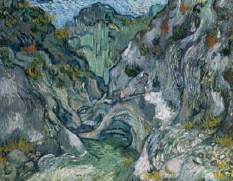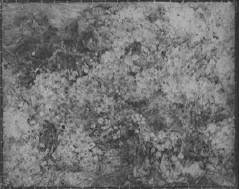
Vincent van Gogh: “Ravine”, 1889
Boston, Museum of Fine Arts

x-ray of van Gogh’s “Ravine”
Museum of Fine Arts, Boston, discovered a van Gogh underneath his work Ravine The Museum of Fine Arts, Boston (MFA), and the Van Gogh Museum, Amsterdam, have discovered a painting by Vincent van Gogh, examining with x-rays his painting Ravine]]>
August 5 2007, source: The Museum of Fine Arts, Boston (MFA), and the Van Gogh Museum, Amsterdam
The Museum of Fine Arts, Boston (MFA), and the Van Gogh Museum, Amsterdam, have discovered a painting by Vincent van Gogh (1853 – 1890) underneath the artist’s painting Ravine, owned by the MFA. Meta Chavannes, the MFA’s Andrew W. Mellon Fellow in Paintings Conservation, was examining x-rays of Ravine in response to a request from outside scholars for technical information on the Museum’s six paintings by Van Gogh. The existence of a complete painting below the Ravine was confirmed by the x-rays and close examination of the paint surface. Upon meeting with the Van Gogh Museum, Amsterdam and Louis van Tilborgh, the Van Gogh research curator at the Van Gogh Museum, it was established that the underlying composition was most likely painted in June 1889, during the early period of Van Gogh’s stay at the asylum of Saint-Paul de Mausole near the Provençal town of Saint-Rémy, and was re-used as a support for Ravine a few months later, in October 1889. Van Tilborgh related the x-radiograph of Ravine to a drawing Van Gogh sent his brother in mid-1889 entitled Wild Vegetation. Scholars have suggested that this drawing, in the Van Gogh Museum, forms part of group of around a dozen drawn copies of paintings that the artist sent to his brother Theo in July 1889, but no painting was known upon which this particular drawing could have been based. As a result of this current research, the lost painting has been re-discovered.
The re-use of canvas is not an unusual phenomenon in Van Gogh’s earlier career, but in 1888 his brother Theo began to supply and pay for all of his painting materials. Thus it is unlikely that he hoped to save money by re-using the Wild Vegetation canvas when he began to paint Ravine in October 1889. In fact, it has become clear from his correspondence with his brother that Theo was late in sending materials in this precise period, and that Vincent had completely run out of canvas by the time he painted Ravine.
In fact, there were four periods in the last two years of Van Gogh’s life in which he ran out of materials impatiently waiting for his brother to forward new canvases and paints. It is as yet unclear whether more than a few paintings on re-used canvas can be ascribed to these periods.
Van Gogh’s pen-and-ink copy of his painting of Wild Vegetation can be seen in the presentation of Van Gogh’s Drawings: New Insights on view at the Van Gogh Museum through October 7, 2007. Ravine—the masterpiece that now covers the earlier painting—is on view in the MFA’s Impressionist Gallery.
Follow us on:

